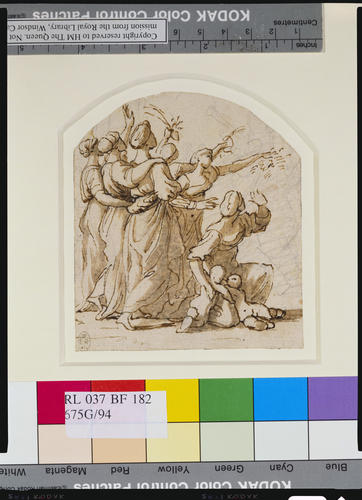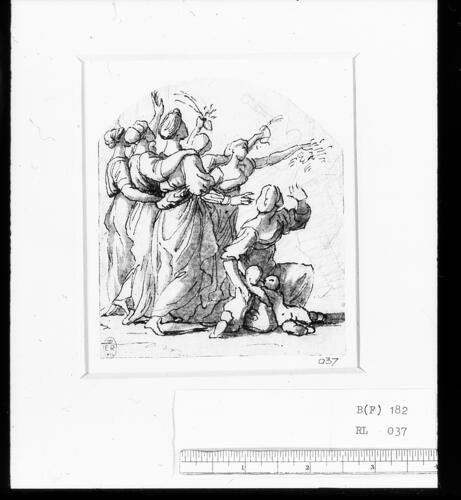A study for the Triumph of David c.1631-32
Graphite underdrawing, pen and brown ink, brown wash | 10.8 x 9.5 cm (arched top) (sheet of paper) | RCIN 990037
-
A drawing of three women linking arms, another seated with infants, others beyond with garlands. This is a study for the figures in the left foreground of the painting of the Triumph of David, now in the Dulwich Picture Gallery. Poussin devoted much effort to this group; an earlier study for the same figures in red chalk at Chantilly bears a pattern of pinholes, exactly corresponding to the bare arm of the woman at the far left and the upper back and head of her companion in the painting. The technique of pricking full-scale designs on large sheets of paper (‘cartoons’), then pouncing dust through the holes to transfer the design to the painting surface, was common practice in the artists' workshops of the Renaissance and Baroque, but this is the only known instance in the whole of Poussin's œuvre. X-ray images of the Dulwich picture reveal the reason for this mechanical operation: the group of three women originally stood as close to the kneeling mother in the painting as they do in the present drawing, some eight inches to the right of their present position, and the cartoon process was used to move them en bloc during the execution of the painting.
In style the painting falls between the 1630-31 Realm of Flora and the 1633 Dresden Adoration; a date of c. 1631-32 for the two drawings thus seems probable. However the authenticity of both Windsor and Chantilly sheets, and indeed the painting itself, has recently been repeatedly questioned. Rosenberg and Prat (1994, no. R1287 and R253) reject both sheets, while accepting the painting. But the present sheet is absolutely in the style of Poussin's drawings of the early 1630s, and the pricking of the Chantilly sheet, when taken with the evidence of the X-rays, makes it methodologically very difficult to doubt.
The three women, and indeed the whole composition, are closely based on a print by Giorgio Ghisi after a design by Giulio Romano for one of a series of tapestries illustrating the exploits of the Roman general Scipio Africanus. The differences between Poussin's painting and the engraving are illuminating: a loosely squared pavement is introduced to give the middle ground some structure; the rabble of a procession is calmed down and spaced out; the background architecture is enlarged in scale to eliminate the fussy line of columns of the print. By the early 1630s Poussin was pursuing space, order and dignity in his compositions.Provenance
Cardinal Camillo Massimi (1620-1677); from whose heirs bought in 1739, for 300 scudi, by Richard Mead (1673-1754); probably presented to Frederick, Prince of Wales, by 1750
-
Creator(s)
Acquirer(s)
-
Medium and techniques
Graphite underdrawing, pen and brown ink, brown wash
Measurements
10.8 x 9.5 cm (arched top) (sheet of paper)
Object type(s)
Other number(s)
Alternative title(s)
Le Donne Israelite










